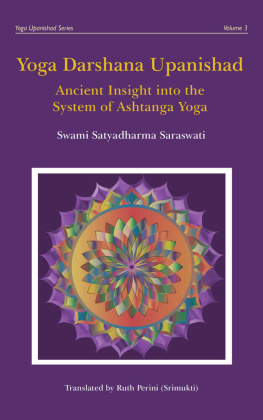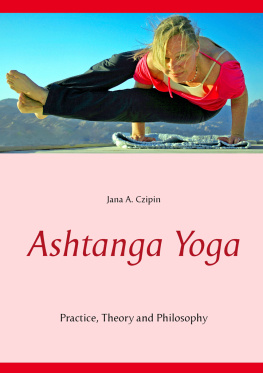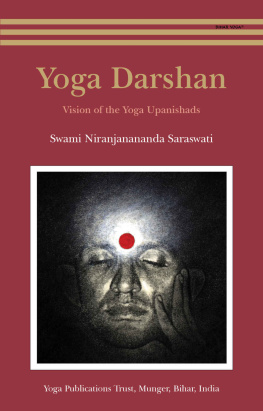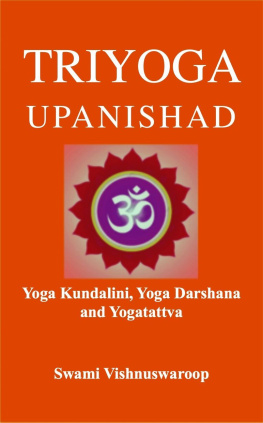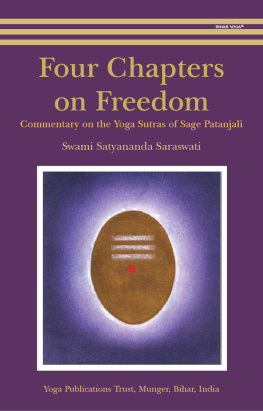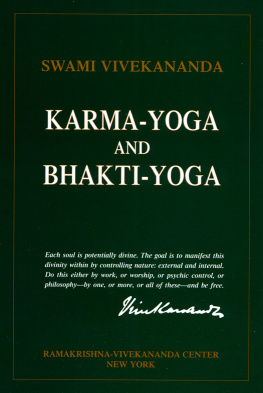Swami Satyadharma Saraswati - Yoga Darshana Upanishad: Ancient Insight into the System of Ashtanga Yoga (Yoga Upanishads Book 3)
Here you can read online Swami Satyadharma Saraswati - Yoga Darshana Upanishad: Ancient Insight into the System of Ashtanga Yoga (Yoga Upanishads Book 3) full text of the book (entire story) in english for free. Download pdf and epub, get meaning, cover and reviews about this ebook. year: 2018, genre: Religion. Description of the work, (preface) as well as reviews are available. Best literature library LitArk.com created for fans of good reading and offers a wide selection of genres:
Romance novel
Science fiction
Adventure
Detective
Science
History
Home and family
Prose
Art
Politics
Computer
Non-fiction
Religion
Business
Children
Humor
Choose a favorite category and find really read worthwhile books. Enjoy immersion in the world of imagination, feel the emotions of the characters or learn something new for yourself, make an fascinating discovery.
- Book:Yoga Darshana Upanishad: Ancient Insight into the System of Ashtanga Yoga (Yoga Upanishads Book 3)
- Author:
- Genre:
- Year:2018
- Rating:3 / 5
- Favourites:Add to favourites
- Your mark:
- 60
- 1
- 2
- 3
- 4
- 5
Yoga Darshana Upanishad: Ancient Insight into the System of Ashtanga Yoga (Yoga Upanishads Book 3): summary, description and annotation
We offer to read an annotation, description, summary or preface (depends on what the author of the book "Yoga Darshana Upanishad: Ancient Insight into the System of Ashtanga Yoga (Yoga Upanishads Book 3)" wrote himself). If you haven't found the necessary information about the book — write in the comments, we will try to find it.
Yoga Darshana Upanishad: Ancient Insight into the System of Ashtanga Yoga (Yoga Upanishads Book 3) — read online for free the complete book (whole text) full work
Below is the text of the book, divided by pages. System saving the place of the last page read, allows you to conveniently read the book "Yoga Darshana Upanishad: Ancient Insight into the System of Ashtanga Yoga (Yoga Upanishads Book 3)" online for free, without having to search again every time where you left off. Put a bookmark, and you can go to the page where you finished reading at any time.
Font size:
Interval:
Bookmark:
Text copyright 2018
Swami Satyadharma Saraswati
Ruth Perini
All Rights Reserved
No part of this publication may be reproduced, transmitted or stored in a retrieval system, in any form or by any means, without permission in writing from the author and translator.
Yoga Upaniad Series Volume 3
Yoga Darana Upaniad
Ancient Insight into the System of Aga Yoga
Original Sanskrit text with
Transliteration, Translation and Commentary
Swm Satyadharma Saraswat
Sannys rimukti (Ruth Perini)
Dedication
To all friends, practitioners and teachers of yoga,
and to all seekers of spiritual wisdom,
regardless of time or place, creed, gender, age or race
CONTENTS
Introduction
Invocation
FIRST SECTION: Aga yoga is the sdhana of the jivanmukta.
Datttreya, avatar and illumined teacher
The worthy disciple
The disciples request
The eight limbs of yoga
The ten yamas, or yogic disciplines
Ahis, non-violence
Satyam, truth
Asteya, honesty
Brahmacarya, abstinence
Day, kindness
Arjavam, straight-forwardness
Kam, patience
Dhti, equanimity
Mithra, moderate diet
auca, cleanliness
The way to know supreme consciousness
SECOND SECTION: Knowledge of The Ten Niyamas, inner disciplines
Ten niyamas
Tapas, austerity
Santoa, contentment
stikya, faith in the higher reality
Dna, giving freely
Worship of wara
Vednta ravana, hearing the knowledge of truth
Hr, remorse or shame
Mati, faith in the vedic teaching
Japa, repetition of the mantra
THIRD SECTION: Nine sanas
Nine major sanas
Swastiksana, the auspicious pose
Gomukhsana, the cow face pose
Padmsana, the lotus pose
Vrsana, the hero pose
Sihsana, the lion pose
Bhadrsana, the gracious pose
Muktsana, liberated pose
Mayursana, the peacock pose
Suksana, the easy pose
Benefits of mastering sana
FOURTH SECTION: The Subtle Body
Center of fire and triangle of akti
Root of the ns
Enumeration of the ns
Brahma and suumn ns
Kualin
Location of the major ns
Termination of the major ns
Ten pras
Functions of the pras
Deities relating with the ns
Lunar and solar movement in the ns
Uttaryan and dakiyan
Equinox and eclipse
Inner pilgrimage places
Vision of iva within oneself
Absorption in Brahma
FIFTH SECTION: Pryma
Purification of the ns
N odhana pryma
Signs of n purification
Purification of the Self
SIXTH SECTION: Aspects of Pryma
Description of pryma
Pryma with praava
Benefits of the practice
Components of pryma
Perfection of pryma
Pryma eradicates disease
amukhi mudr controls pra
Signs of the conquest of vyu
Dawning of vairagya and removal of disease and sin
SEVENTH SECTION: Pratyhra
Description of pratyhra
Pratyhra by focusing on pra
Benefits of pratyhra
Pratyhra by focusing on pra (method 2)
Pratyhra according to vednta
EIGHTH SECTION: Dhra
Paca bhta dhra, concentration on the five elements
Dhra on the Self
NINTH SECTION: Dhyna
Meditation on Brahma with attributes
Meditation on Brahma without attributes
Fruits of Meditation
TENTH SECTION: Samdhi
Nature of samdhi
Only Brahma remains
Epilogue
APPENDICES
Sanskrit text
Pronunciation Guide
Continuous Translation
About the Author
About the Translator
Introduction
Veda is a Sanskrit word meaning knowledge. In the context of the Vedas, it means revealed knowledge which is ruti , heard from within, not taught. These ancient spiritual texts or hymns, through which we can learn much of the perceptions and insights of the early vedic seers, are grouped into four samhitas or collections: Rig Veda, Yajur Veda, Sma Veda and Atharva Veda . They were revealed to enlightened beings 3,000 to 4,500 years ago or more (the Rig-Veda contains astronomical references describing occurrences in 5,000 to 3,000 BCE), and transmitted orally by the sages from generation to generation within brahmin families.
The four Vedas were considered to be divine revelations, and each word was carefully memorised. This was to ensure accurate transmission, but also because each syllable was considered to have spiritual power, its source being the supreme, eternal sound. This was a mammoth task, as there are 20,358 verses in the four Vedas, approximately two thousand printed pages. They were composed in fifteen different metres, which demanded perfect control of the breath. Georg Feuerstein describes them as a composite of symbol, metaphor, allegory, myth and story, as well as paradox and riddle and their composers as recipients and revealers of the invisible order of the cosmos [with] inspired insights or illumined visions1.
Rig Veda
The Rig Veda is the oldest spiritual text in the world and still regarded as sacred, containing 1,028 hymns or songs of 10,589 verses in praise of the divine ( rig or ric meaning praise). Each hymn is recognised as a mantra , a sacred sound vibration, which releases energy from limited material awareness, thus expanding the consciousness . It is also the earliest surviving form of Sanskrit. The illumined seers composed the hymns while established in the highest consciousness, thus able to commune with luminous beings of the higher realms. There are about 250 hymns in praise of Indra , the divine force behind the ocean, heavens, thunder, lightning, rain and the light of the sun; 200 of Agni , born of the Sun, becoming the god of sacrificial fire, and over 100 of Soma , who gives immortality, and who is connected to the Sun, Moon, mountains, rivers and oceans. Others are dedicated to Varuna , who protects cosmic order; the Ashvins , supreme healers; Ushas , goddess of the dawn; Aditi , goddess of eternity; and Saraswati , goddess of the Vedas and of music and the arts.
Yajur Veda
The hymns of the Yajur-Veda, Veda of Sacrifice, consist of sacrificial formulas or prayers, including those of an internal or spiritual nature, which are chanted by the adhvaryu (priest), who performs the sacrifice. About a third of its 1,975 verses are taken from the Rig Veda . The rest are original and in prose form.
Sma Veda
The Sma Veda , Veda of Chants, gives instructions on the chanting of vedic hymns. The majority of its 1,875 verses are from the Rig Veda; only 75 verses are original. Many of the hymns were sung by special priests during sacrificial rites. Some are still sung today.
Atharva Veda
The Atharva Veda, named after the seer Atharvan, whose family were great seers in vedic times, contains 731 hymns of 5,977 verses, about one fifth of which are from the RigVeda . Much of the Atharva Veda consists of magical spells and charms for gaining health, love, peace and prosperity, or taking revenge on an enemy. Possibly for this reason, the Atharva Veda was either not accepted by the orthodox priesthood, or not given the same standing as the other Vedas.
The vedic people and their culture
The vedic people lived for over 2,500 years mainly along the banks of the Saraswati River, which was located in Northern India between the modern Ravi and Yamuna Rivers down to what is now the desert of Rajasthan. The Saraswati River dried up in about 1,900 BCE due to tectonic upheavals. Other areas of habitation included the Ganges River and its tributaries, rivers in Afghanistan (previously called Gandhara), the Himalayas and Mount Kailash in Tibet.
The vedic people had a complex multi-tiered view of the universe, in which humankind, nature and the divine are intertwined and interrelated. They had a deep knowledge of the oceans, mountains, deserts and forests of the physical world, as well as of the subtle worlds of deities and different levels of consciousness. People lived in cities or villages or were nomads, and were fully engaged in worldly life. They were an agrarian people, yet also had herds of cattle, horses and camels. Cities were constructed of stone, bricks and metal. They built chariots and ships. They were skilled workers in gold, metal, clay, stone, wood, leather and wool, and showed a very high standard in arts, crafts, astrology, medicine, music, dance and poetry.
Next pageFont size:
Interval:
Bookmark:
Similar books «Yoga Darshana Upanishad: Ancient Insight into the System of Ashtanga Yoga (Yoga Upanishads Book 3)»
Look at similar books to Yoga Darshana Upanishad: Ancient Insight into the System of Ashtanga Yoga (Yoga Upanishads Book 3). We have selected literature similar in name and meaning in the hope of providing readers with more options to find new, interesting, not yet read works.
Discussion, reviews of the book Yoga Darshana Upanishad: Ancient Insight into the System of Ashtanga Yoga (Yoga Upanishads Book 3) and just readers' own opinions. Leave your comments, write what you think about the work, its meaning or the main characters. Specify what exactly you liked and what you didn't like, and why you think so.

